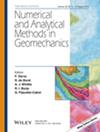Closed-Form Solutions of Translatory Coal Seam Bumps Considering the Intermediate Principal Stress and Gas Pressure
Abstract
Translatory bumps are becoming a major challenge in the excavation of coal seams. This study presents closed-form solutions of stress and plastic zone width for translatory coal seam bumps within the framework of the Lippmann theory. The strength of coal seam taken as an elastic−perfectly plastic material and the friction force at the coal−rock interface are evaluated by the generalized effective stress with consideration of gas pressure. The Unified Strength Theory is adopted to address the contributions of intermediate principal stress on the strength improvements of the coal seam. The orderly serialized solution obtained in this study is formatted into three sets in accordance with linear, exponential, and sinusoidal profiles of gas pressure, and its validity is demonstrated by comparing it with both published theoretical solutions and numerical simulations. In addition, discussions are conducted between the results from three profiles of gas pressure and varying influencing extents of intermediate principal stress. Parametric studies highlight that the effect of gas pressure is significant, especially for the exponential profile with a weaker effect of intermediate principal stress; the translatory bump tendency is high for the coal seam with great depth and thin thickness; the internal friction angle of coal seam has a more pronounced impact than the cohesion of coal seam.

 求助内容:
求助内容: 应助结果提醒方式:
应助结果提醒方式:


